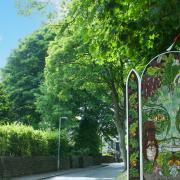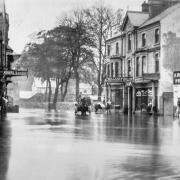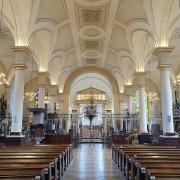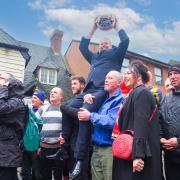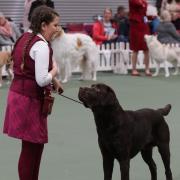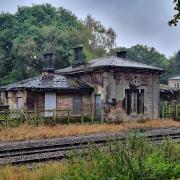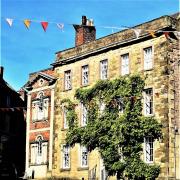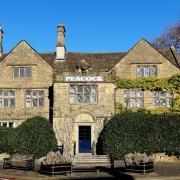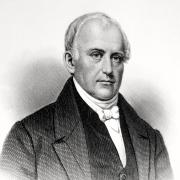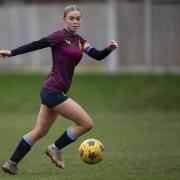Richard Bradley observes some of our county's more outlandish religious symbols
Derbyshire’s churches provide many of our county’s oldest surviving buildings.
Village churches, especially, have provided a focal point for hundreds - occasionally thousands - of years for the local community.
For generation after generation, Derbyshire people have visited them regularly to worship, before being laid to rest in the graveyard outside.
Yet despite the steadfast, calming and ultimately pious atmosphere which they exude, churches across our county also have a strange knack for ending up as repositories for bizarre artefacts.
These often appear to hark back to the earlier, more mysterious nature-worshipping pagan religions predating Christianity – or objects which have far-fetched folk legends attached to them.
If you enter the church of St James at Brassington and look upwards, for example, you receive a charming welcome from a carving in the ancient stonework depicting a naked and very obviously male figure mooning at you whilst leering over his shoulder.
What is his purpose in this most holy of buildings? The church guidebook merely notes wearily that the carving ‘suggests that our medieval forbears were more broadminded than us about what is suitable decoration for a church’.

The same can be said for another male gargoyle figure which can be found on the exterior of St Peter’s Church, Hope, who appears to be what can only be described as pleasuring himself.
At the ancient church of St Helen, Churchtown, in Darley Dale, can be found a female counterpart in the form of a Sheela-na-gig, a weathered stylised carving of a crude female figure exposing her genitals.
Similar carvings appear at churches across Europe and are thought to be symbolic fertility symbols.
Whilst to our modern eyes it may seem highly surprising to encounter such explicit carvings in a church, Geoffrey R. Sharpe explains in Historic English churches - a guide to their construction, design and features: ‘The early Christian missionaries recognised the important role that pagan shrines and symbols could play in the promotion of Christianity, and took great care not to alienate the pagan communities through force or undue pressure.
‘In this, they deliberately avoided presenting their message as a replacement for an existing ideology and began by either adapting or incorporating pagan icons into the practices of the early Church.
‘This is why so many pagan symbols continued to appear on items such as gargoyles, corbels, brackets, misericords, capitals and bosses until the time of the Tudors’.
Chesterfield’s Parish Church of St. Mary and All Saints is of course well known for its Crooked Spire, the more informal name that most of us Derbyshire folk know the building as.

But lurking inside the church’s impressive interior can be found a lesser-known oddity: the Dun Cow’s Rib.
This large, curved bone is supposed to have belonged to a fabled beast, the Dun Cow, who as a public service would magnanimously allow herself to be milked by anyone who brought a vessel along to be filled.
There’s always someone who has to spoil things for everyone else though, and sure enough one day an exploitative witch came along armed with a sieve.
Enraged at being taken advantage of in this fashion, the formerly philanthropic creature went mad and subsequently had to be slain by Guy of Warwick.
When George Hall was writing his History of Chesterfield in 1839, he suggested an alternative origin for the bone, saying it is ‘supposed to be the rib of a Mammoth’.
In fact, tests by experts at the Natural History Museum in 1992 confirmed that the previous owner of the bone was neither a Dun Cow nor a Mammoth, but actually a young whale.
What a young whale was doing 80 miles inland at Chesterfield, or how its rib came to be displayed in the parish church, they were not able to provide answers for.
The North Transept of the Church was formerly home to a carving known as the Chesterfield Imp (or Chesterfield Sprite), who was located above the choir vestry.
Unfortunately, he was a casualty of the disastrous 1961 fire which broke out at the church, being so badly burnt and smoke blackened as to be thought unsalvageable.
Before he was disposed of, the vicar of the time, Revered Dilworth Harrison, commissioned local firm Pearsons Pottery to produce a few copies of the sprite as a record of his existence, one of which can be seen on display in Chesterfield Museum.

Bonsall St James the Apostle still has their own Bonsall Imp in situ on the base of a column in the north aisle, as well as a large stone with an iron bull-baiting ring set into it, said to have been confiscated and placed in the church in 1815 by an animal-loving rector who objected to the practice of bulls being baited as supposed entertainment at the annual Bonsall Wakes carnival.
Churches in North East Derbyshire remember the local mining industry which was once so prevalent in the district until the closure of the mines in the later 20th century.
Over the door at Bolsover church is to be found the NUM Bolsover Branch banner, once proudly paraded through the streets during the 1984-5 Miners’ Strike.
A constantly-burning miner’s lamp (run on electricity) provides the sanctuary lamp for the churches at Bolsover, Staveley and Ault Hucknall.

Inside a display case on the wall of St Anne’s Church at Baslow is their preserved dog whip; the tool was used for exactly what you would expect from its name, although the scenario may seem far-fetched for us to now envisage.
But clearly in days of yore, the phenomenon of dogs entering church buildings and running around causing havoc during a service was commonplace enough that someone was employed to whip any stray dogs who behaved in this distracting fashion so that they swiftly about-turned and exited the building.
Whilst their whip has not survived, the parish registers of Youlgrave All Saints Church record the salary for their resident dog whipper for a period of over several hundred years – a Herbert Walton received 16 pence ‘for whipping ye dogges forth of ye churche in tyme of divyne service’ in 1609.
A laminated sign on the back of the church door at Baslow suggests that the building is still susceptible to invasion by animals to this day: ‘Please come in – help keep the birds and bats out – do close the door’.
The dog whip was not the only weapon wielded by church officials in days of yore to keep order during services.
If you chanced to fall asleep during a sermon at Dronfield church then you would be in danger of reprimand from the patrolling ‘Knock-Nobbler’.
Sidney Oldall Addy, who compiled a dialect dictionary of A Glossary of Words used in the neighbourhood of Sheffield in 1888, defines Knock-Nobbler: ‘This term was applied to a verger or sexton of Dronfield church, who during service used to walk up and down the church with a long stick. With this he nobbled the heads of sleepers.’
Frank Rodgers in Curiosities of Derbyshire and the Peak District records someone performing a similar duty at Castleton in 1722, except here the job description was termed ‘Sluggard Walker’.
So next time you happen to be in a Derbyshire church, take a look around you. You’ll often find more than immediately meets the eye.








